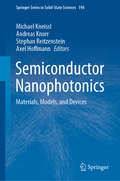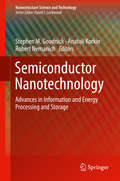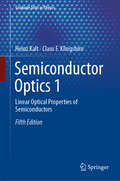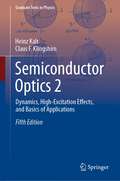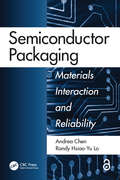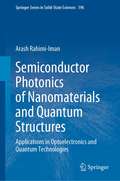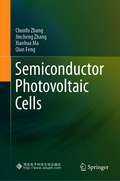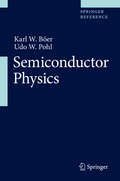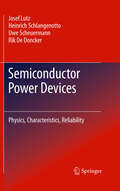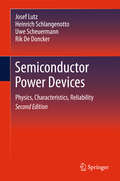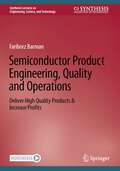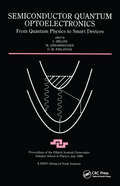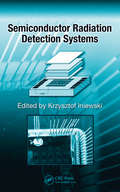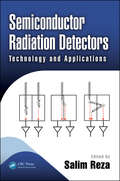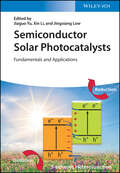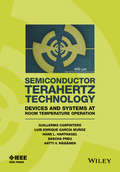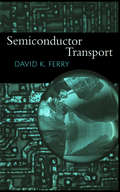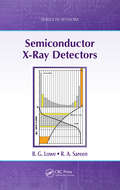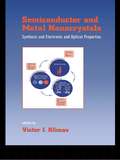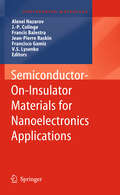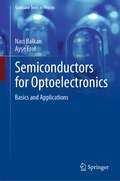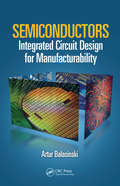- Table View
- List View
Semiconductor Nanophotonics: Materials, Models, and Devices (Springer Series in Solid-State Sciences #194)
by Andreas Knorr Michael Kneissl Axel Hoffmann Stephan ReitzensteinThis book provides a comprehensive overview of the state-of-the-art in the development of semiconductor nanostructures and nanophotonic devices. It covers epitaxial growth processes for GaAs- and GaN-based quantum dots and quantum wells, describes the fundamental optical, electronic, and vibronic properties of nanomaterials, and addresses the design and realization of various nanophotonic devices. These include energy-efficient and high-speed vertical cavity surface emitting lasers (VCSELs) and ultra-small metal-cavity nano-lasers for applications in multi-terabus systems; silicon photonic I/O engines based on the hybrid integration of VCSELs for highly efficient chip-to-chip communication; electrically driven quantum key systems based on q-bit and entangled photon emitters and their implementation in real information networks; and AlGaN-based deep UV laser diodes for applications in medical diagnostics, gas sensing, spectroscopy, and 3D printing. The experimental results are accompanied by reviews of theoretical models that describe nanophotonic devices and their base materials. The book details how optical transitions in the active materials, such as semiconductor quantum dots and quantum wells, can be described using a quantum approach to the dynamics of solid-state electrons under quantum confinement and their interaction with phonons, as well as their external pumping by electrical currents. With its broad and detailed scope, this book is indeed a cutting-edge resource for researchers, engineers and graduate-level students in the area of semiconductor materials, optoelectronic devices and photonic systems.
Semiconductor Nanotechnology: Advances in Information and Energy Processing and Storage (Nanostructure Science and Technology)
by Stephen M. Goodnick Anatoli Korkin Robert NemanichThis book presents research dedicated to solving scientific and technological problems in many areas of electronics, photonics and renewable energy. Energy and information are interconnected and are essential elements for the development of human society. Transmission, processing and storage of information requires energy consumption, while the efficient use and access to new energy sources requires new information (ideas and expertise) and the design of novel systems such as photovoltaic devices, fuel cells and batteries. Semiconductor physics creates the knowledge base for the development of information (computers, cell phones, etc.) and energy (photovoltaic) technologies. The exchange of ideas and expertise between these two technologies is critical and expands beyond semiconductors. Continued progress in information and renewable energy technologies requires miniaturization of devices and reduction of costs, energy and material consumption. The latest generation of electronic devices is now approaching nanometer scale dimensions, new materials are being introduced into electronics manufacturing at an unprecedented rate, and alternative technologies to mainstream CMOS are evolving. Nanotechnology is widely accepted as a source of potential solutions in securing future progress for information and energy technologies.Semiconductor Nanotechnology features chapters that cover the following areas: atomic scale materials design, bio- and molecular electronics, high frequency electronics, fabrication of nanodevices, magnetic materials and spintronics, materials and processes for integrated and subwave optoelectronics, nanoCMOS, new materials for FETs and other devices, nanoelectronics system architecture, nano optics and lasers, non-silicon materials and devices, chemical and biosensors, quantum effects in devices, nano science and technology applications in the development of novel solar energy devices, and fuel cells and batteries.
Semiconductor Optics 1: Linear Optical Properties of Semiconductors (Graduate Texts in Physics)
by Heinz Kalt Claus F. KlingshirnThis revised and updated edition of the well-received book by C. Klingshirn provides an introduction to and an overview of all aspects of semiconductor optics, from IR to visible and UV. It has been split into two volumes and rearranged to offer a clearer structure of the course content. Inserts on important experimental techniques as well as sections on topical research have been added to support research-oriented teaching and learning. Volume 1 provides an introduction to the linear optical properties of semiconductors. The mathematical treatment has been kept as elementary as possible to allow an intuitive approach to the understanding of results of semiconductor spectroscopy. Building on the phenomenological model of the Lorentz oscillator, the book describes the interaction of light with fundamental optical excitations in semiconductors (phonons, free carriers, excitons). It also offers a broad review of seminal research results augmented by concise descriptions of the relevant experimental techniques, e.g., Fourier transform IR spectroscopy, ellipsometry, modulation spectroscopy and spatially resolved methods, to name a few. Further, it picks up on hot topics in current research, like quantum structures, mono-layer semiconductors or Perovskites. The experimental aspects of semiconductor optics are complemented by an in-depth discussion of group theory in solid-state optics. Covering subjects ranging from physics to materials science and optoelectronics, this book provides a lively and comprehensive introduction to semiconductor optics. With over 120 problems, more than 480 figures, abstracts to each chapter, as well as boxed inserts and a detailed index, it is intended for use in graduate courses in physics and neighboring sciences like material science and electrical engineering. It is also a valuable reference resource for doctoral and advanced researchers.
Semiconductor Optics 2: Dynamics, High-Excitation Effects, and Basics of Applications (Graduate Texts in Physics)
by Heinz Kalt Claus F. KlingshirnThis book provides an introduction to and an overview of the multifaceted area of dynamics and nonlinearities related to optical excitations in semiconductors. It is a revised and significantly extended edition of the well-established book by C. Klingshirn split into two volumes and restructured to make it more concise. Inserts on important experimental techniques, reference to topical research and novel materials, as well as consideration of photonic applications support research-oriented teaching and learning. This book reviews nonlinear optical properties and many-body phenomena evoked by high densities of quasi-particles in semiconductors. Coherent dynamics and relaxation of optical excitations (carriers, excitons, electron–hole plasmas, etc.) as well as condensation phenomena are elucidated in these materials. A broad overview is provided of seminal research results augmented by detailed descriptions of the relevant experimental techniques, e.g., ultrafastspectroscopy, four-wave mixing, and the Hanbury-Brown and Twiss experiment. Offering a comprehensive introduction to hot topics in current research — polariton condensates, valley coherence, and single photons, to name a few, it also discusses applications of the described physical concepts in topical areas, such as quantum information, photonics, spintronics, and optoelectronics.Covering subjects ranging from physics to materials science and optoelectronics, the book provides a lively and comprehensive introduction to semiconductor optics beyond the linear regime.With many problems, chapter introductions, schematic depictions of physical phenomena, as well as boxed inserts and a detailed index, it is suitable for use in graduate courses in physics and neighboring sciences like material science and optical communication. It is also a valuable reference resource for doctoral and advanced researchers.
Semiconductor Packaging: Materials Interaction and Reliability
by Andrea Chen Randy Hsiao-Yu LoIn semiconductor manufacturing, understanding how various materials behave and interact is critical to making a reliable and robust semiconductor package. Semiconductor Packaging: Materials Interaction and Reliability provides a fundamental understanding of the underlying physical properties of the materials used in a semiconductor package. By tying together the disparate elements essential to a semiconductor package, the authors show how all the parts fit and work together to provide durable protection for the integrated circuit chip within as well as a means for the chip to communicate with the outside world. The text also covers packaging materials for MEMS, solar technology, and LEDs and explores future trends in semiconductor packages.
Semiconductor Photonics of Nanomaterials and Quantum Structures: Applications in Optoelectronics and Quantum Technologies (Springer Series in Solid-State Sciences #196)
by Arash Rahimi-ImanThis book introduces the wider field of functional nanomaterials sciences, with a strong emphasis on semiconductor photonics. Whether you are studying photonic quantum devices or just interested in semiconductor nanomaterials and their benefits for optoelectronic applications, this book offers you a pedagogical overview of the relevant subjects along with topical reviews. The book discusses different yet complementary studies in the context of ongoing international research efforts, delivering examples from both fundamental and applied research to a broad readership. In addition, a hand-full of useful optical techniques for the characterization of semiconductor quantum structures and materials are addressed. Moreover, nanostructuring methods for the production of low-dimensional systems, which exhibit advantageous properties predominantly due to quantum effects, are summarized. Science and engineering professionals in the interdisciplinary domains of nanotechnology, photonics, materials sciences, and quantum physics can familiarize themselves with selected highlights with eyes towards photonic applications in the fields of two-dimensional materials research, light–matter interactions, and quantum technologies.
Semiconductor Photovoltaic Cells
by Chunfu Zhang Jincheng Zhang Xiaohua Ma Qian FengThis book explores the scientific basis of the photovoltaic effect, solar cell operation, various types of solar cells, and the main process used in their manufacture. It addresses a range of topics, including the production of solar silicon; silicon-based solar cells and modules; the choice of semiconductor materials and their production-relevant costs and performance; device structures, processing, and manufacturing options for the three major thin-film PV technologies; high-performance approaches for multi-junction, concentrator, and space applications; and new types of organic polymer and dye-sensitized solar cells. The book also presents a concept for overcoming the efficiency limit of today’s solar cells. Accessible for beginners, while also providing detailed information on the physics and technology for experts, the book is a valuable resource for researchers, engineers, and graduate students in fields such as physics, materials, energy, electrical and electronic engineering and microelectronics.
Semiconductor Physics
by Udo W. Pohl Karl W. BöerThis handbook gives a complete and detailed survey of the field of semiconductor physics. It addresses every fundamental principle, the most important research topics and results, as well as conventional and emerging new areas of application. Additionally it provides all essential reference material on crystalline bulk, low-dimensional, and amorphous semiconductors, including valuable data on their optical, transport, and dynamic properties.This updated and extended second edition includes essential coverage of rapidly advancing areas in semiconductor physics, such as topological insulators, quantum optics, magnetic nanostructures and spintronic systems. Richly illustrated and authored by a duo of internationally acclaimed experts in solar energy and semiconductor physics, this handbook delivers in-depth treatment of the field, reflecting a combined experience spanning several decades as both researchers and educators. Offering a unique perspective on many issues, Semiconductor Physics is an invaluable reference for physicists, materials scientists and engineers throughout academia and industry.
Semiconductor Physics: Introduction To Physical Principles (Graduate Texts in Physics #4)
by Udo W. Pohl Karl W. BöerThis handbook gives a complete survey of the important topics and results in semiconductor physics. It addresses every fundamental principle and most research topics and areas of application in the field of semiconductor physics. Comprehensive information is provided on crystalline bulk and low-dimensional as well as amporphous semiconductors, including optical, transport, and dynamic properties.
Semiconductor Power Devices
by Josef Lutz Heinrich Schlangenotto Rik De Doncker Uwe ScheuermannSemiconductor power devices are the heart of power electronics. They determine the performance of power converters and allow topologies with high efficiency. Semiconductor properties, pn-junctions and the physical phenomena for understanding power devices are discussed in depth. Working principles of state-of-the-art power diodes, thyristors, MOSFETs and IGBTs are explained in detail, as well as key aspects of semiconductor device production technology. In practice, not only the semiconductor, but also the thermal and mechanical properties of packaging and interconnection technologies are essential to predict device behavior in circuits. Wear and aging mechanisms are identified and reliability analyses principles are developed. Unique information on destructive mechanisms, including typical failure pictures, allows assessment of the ruggedness of power devices. Also parasitic effects, such as device induced electromagnetic interference problems, are addressed. The book concludes with modern power electronic system integration techniques and trends.
Semiconductor Power Devices
by Josef Lutz Heinrich Schlangenotto Rik De Doncker Uwe ScheuermannHalbleiter-Leistungsbauelemente sind das Kernstück der Leistungselektronik. Sie bestimmen die Leistungsfähigkeit und machen neuartige und verlustarme Schaltungen erst möglich. In dem Band wird neben den Halbleiter-Leistungsbauelementen selbst auch die Aufbau- und Verbindungstechnik behandelt: von den physikalischen Grundlagen und der Herstellungstechnologie über einzelne Bauelemente bis zu thermomechanischen Problemen, Zerstörungsmechanismen und Störungseffekten. Die 2., überarbeitete Auflage berücksichtigt technische Neuerungen und Entwicklungen.
Semiconductor Product Engineering, Quality and Operations: Deliver High Quality Products & Increase Profits (Synthesis Lectures on Engineering, Science, and Technology)
by Fariborz BarmanThis book captures the author’s 35+ years of learning & experience in the semiconductor chip industry to provide a proven roadmap for successful, new product introduction process, tailored specifically to the semiconductor industry. The content includes a simplified process flow, success metrics, execution guidelines, checklists & calculators. The presentation is based on a product engineering centric “NPI hub” and the author guides readers through the complete process of semiconductor new product introduction, ensuring a successful plan execution.
Semiconductor Quantum Optoelectronics: From Quantum Physics to Smart Devices (Scottish Graduate Ser. #50)
by A Miller; M Ebrahimzadeh; D M FinlaysonThe development and application of low-dimensional semiconductors have been rapid and spectacular during the past decade. Ever improving epitaxial growth and device fabrication techniques have allowed access to some remarkable new physics in quantum confined structures while a plethora of new devices has emerged. The field of optoelectronics in particular has benefited from these advances both in terms of improved performance and the invention of fundamentally new types of device, at a time when the use of optics and lasers in telecommunications, broadcasting, the Internet, signal processing, and computing has been rapidly expanding. An appreciation of the physics of quantum and dynamic electronic processes in confined structures is key to the understanding of many of the latest devices and their continued development.Semiconductor Quantum Optoelectronics covers new physics and the latest device developments in low-dimensional semiconductors. It allows those who already have some familiarity with semiconductor physics and devices to broaden and expand their knowledge into new and expanding topics in low-dimensional semiconductors. The book provides pedagogical coverage of selected areas of new and pertinent physics of low-dimensional structures and presents some optoelectronic devices presently under development. Coverage includes material and band structure issues and the physics of ultrafast, nonlinear, coherent, intersubband, and intracavity phenomena. The book emphasizes various devices, including quantum wells, visible, quantum cascade, and mode-locked lasers; microcavity LEDs and VCSELs; and detectors and logic elements. An underlying theme is high-speed phenomena and devices for increased system bandwidths.
Semiconductor Quantum Well Intermixing: Material Properties and Optoelectronic Applications
by E. Herbert LiSemiconductor Quantum Well Intermixing is an international collection of research results dealing with several aspects of the diffused quantum well (DFQW), ranging from Physics to materials and device applications. The material covered is the basic interdiffusion mechanisms of both cation and anion groups as well as the properties of band structure
Semiconductor Radiation Detection Systems (Devices, Circuits, and Systems)
by Krzysztof IniewskiSemiconductor Radiation Detection Systems addresses the state-of-the-art in the design of semiconductor detectors and integrated circuit design, in the context of medical imaging using ionizing radiation. It addresses exciting new opportunities in X-ray detection, Computer Tomography (CT), bone dosimetry, and nuclear medicine (PET, SPECT). In addition to medical imaging, the book explores other applications of semiconductor radiation detection systems in security applications such as luggage scanning, dirty bomb detection, and border control. Features a chapter written by well-known Gamma-Ray Imaging authority Tadayuki Takahashi Assembled by a combination of top industrial experts and academic professors, this book is more than just a product manual. It is practical enough to provide a solid explanation of presented technologies, incorporating material that offers an optimal balance of scientific and academic theory. With less of a focus on math and physical details, the author concentrates more on exploring exactly how technologies are being used. With its combined coverage of new materials and innovative new system approaches, as well as a succinct overview of recent developments, this book is an invaluable tool for any engineer, professional, or student working in electronics or an associated field.
Semiconductor Radiation Detectors: Technology and Applications (Devices, Circuits, and Systems)
by Salim RezaThe aim of this book is to educate the reader on radiation detectors, from sensor to read-out electronics to application. Relatively new detector materials, such as CdZTe and Cr compensated GaAs, are introduced, along with emerging applications of radiation detectors. This X-ray technology has practical applications in medical, industrial, and security applications. It identifies materials based on their molecular composition, not densities as the traditional transmission equipment does. With chapters written by an international selection of authors from both academia and industry, the book covers a wide range of topics on radiation detectors, which will satisfy the needs of both beginners and experts in the field.
Semiconductor Solar Photocatalysts: Fundamentals and Applications
by Jiaguo YuProvides a timely overview of basic principles and significant advances of semiconductor-based photocatalysts for solar energy conversion Semiconductor Solar Photocatalysts: Fundamentals and Applications presents a systematic, in-depth summary of both fundamental and cutting-edge research in novel photocatalytic systems. Focusing on photocatalysts with vast potential for efficient utilization of solar energy, this up-to-date volume covers heterojunction systems, graphene-based photocatalysts, organic semiconductor photocatalysts, metal sulfide semiconductor photocatalysts, and graphitic carbon nitride-based photocatalysts. Organized into six chapters, the text opens with a detailed introduction to the history, design principles, modification strategies, and performance evaluation methods of solar energy photocatalysis. The remaining chapters provide detailed discussion of various novel photocatalytic systems such as direct Z-scheme and S-scheme photocatalysts, organic polymers, and covalent organic frameworks. This authoritative resource: Explains the essential concepts of solar energy photocatalysis and heterojunction systems for photocatalysis Reviews interesting structures and new applications of semiconductor photocatalysts Features contributions from an international panel of leading researchers in the field Includes extensive references and numerous tables, figures, and color illustrations Semiconductor Solar Photocatalysts: Fundamentals and Applications is valuable resource for all catalytic chemists, materials scientists, inorganic and physical chemists, chemical engineers, and physicists working in the semiconductor industry.
Semiconductor Technologies in the Era of Electronics
by Yong Hoon KangTechnological advances in the field of materials, devices, circuits, and systems began by the discovery of new properties of objects, or the entrepreneurship with the applications of unique or practical concepts for commercial goods. To implement products using these findings and challenges textbook knowledge is usually sufficient. Semiconductor Technologies in the Era of Electronics therefore does not aim to look deeper in certain areas but it offers a broad and comprehensive overview of the field to: - Experts of specific knowledge who want to expand the overall understanding to different areas - Persons who wish to understand the principle of electronic devices often seen in everyday life - Entrepreneurs interested in the innovations and changes of semiconductor technologies and overall electronics industry A profound and theoretical approach is therefore used and special cases essential to understanding these important concept are presented.
Semiconductor TeraHertz Technology: Devices and Systems at Room Temperature Operation (Wiley - IEEE)
by Hans Hartnagel Guillermo Carpintero Enrique Garcia-Munoz Sascha Preu Antti RaisanenKey advances in Semiconductor Terahertz (THz) Technology now promises important new applications enabling scientists and engineers to overcome the challenges of accessing the so-called "terahertz gap". This pioneering reference explains the fundamental methods and surveys innovative techniques in the generation, detection and processing of THz waves with solid-state devices, as well as illustrating their potential applications in security and telecommunications, among other fields. With contributions from leading experts, Semiconductor Terahertz Technology: Devices and Systems at Room Temperature Operation comprehensively and systematically covers semiconductor-based room temperature operating sources such as photomixers, THz antennas, radiation concepts and THz propagation as well as room-temperature operating THz detectors. The second part of the book focuses on applications such as the latest photonic and electronic THz systems as well as emerging THz technologies including: whispering gallery resonators, liquid crystals, metamaterials and graphene-based devices. This book will provide support for practicing researchers and professionals and will be an indispensable reference to graduate students in the field of THz technology. Key features: Includes crucial theoretical background sections to photomixers, photoconductive switches and electronic THz generation & detection. Provides an extensive overview of semiconductor-based THz sources and applications. Discusses vital technologies for affordable THz applications. Supports teaching and studying increasingly popular courses on semiconductor THz technology.
Semiconductor Transport (Physics Of Solids And Liquids Ser. #52)
by David FerryThe information revolution would have been radically different, or impossible, without the use of the materials known generically as semiconductors. The properties of these materials, particularly the potential for doping with impurities to create transistors and diodes and controlling the local potential by gates, are essential for microelectronics.Semiconductor Transport is an introductory text on electron transport in semiconductor materials and is written for advanced undergraduates and graduate students. The book provides a thorough treatment of modern approaches to the transport properties of semiconductors and their calculation. It also introduces those aspects of solid state physics, which are vitally important for understanding transport in them.
Semiconductor X-Ray Detectors (ISSN #12)
by B. G. Lowe R. A. SareenIdentifying and measuring the elemental x-rays released when materials are examined with particles (electrons, protons, alpha particles, etc.) or photons (x-rays and gamma rays) is still considered to be the primary analytical technique for routine and non-destructive materials analysis. The Lithium Drifted Silicon (Si(Li)) X-Ray Detector, with its
Semiconductor and Metal Nanocrystals: Synthesis and Electronic and Optical Properties (Optical Science And Engineering Ser.)
by Victor I. KlimovThe vast technological potential of nanocrystalline materials, as well as current intense interest in the physics and chemistry of nanoscale phenomena, has led to explosive growth in research on semiconductor nanocrystals, also known as nanocrystal quantum dots, and metal nanoparticles. Semiconductor and Metal Nanocrystals addresses current topics impacting the field including synthesis and assembly of nanocrystals, theory and spectroscopy of interband and intraband optical transitions, single-nanocrystal optical and tunneling spectroscopies, electrical transport in nanocrystal assemblies, and physical and engineering aspects of nanocrystal-based devices. Written by experts who have contributed pioneering research, this reference comprises key advances in the field of semiconductor nanocrystal quantum dots and metal nanoparticles over the past several years. Focusing specifically on nanocrystals generated through chemical techniques, Semiconductor and Metal Nanocrystals Merges investigative frontiers in physics, chemistry, and engineeringDocuments advances in nanocrystal synthesis and assemblyExplores the theory of electronic excitations in nanoscale particlesPresents comprehensive information on optical spectroscopy of interband and intraband optical transitionsReviews data on single-nanocrystal optical and tunneling spectroscopiesWeighs controversies related to carrier relaxation dynamics in ultrasmall nanoparticlesDiscusses charge carrier transport in nanocrystal assemblies Provides examples of lasing and photovoltaic nanocrystal-based devices Semiconductor and Metal Nanocrystals is a must read for scientists, engineers, and upper-level undergraduate and graduate students interested in the physics and chemistry of nanoscale semiconductor and metal particles, as well as general nanoscale science.
Semiconductor-On-Insulator Materials for Nanoelectronics Applications
by Francis Balestra Alexei Nazarov Francisco Gamiz J. P. Colinge Jean-Pierre Raskin V. S. Lysenko"Semiconductor-On-Insulator Materials for NanoElectronics Applications" is devoted to the fast evolving field of modern nanoelectronics, and more particularly to the physics and technology of nanoelectronic devices built on semiconductor-on-insulator (SemOI) systems. The book contains the achievements in this field from leading companies and universities in Europe, USA, Brazil and Russia. It is articulated around four main topics: 1. New semiconductor-on-insulator materials; 2. Physics of modern SemOI devices; 3. Advanced characterization of SemOI devices; 4. Sensors and MEMS on SOI. "Semiconductor-On-Insulator Materials for NanoElectonics Applications" is useful not only to specialists in nano- and microelectronics but also to students and to the wider audience of readers who are interested in new directions in modern electronics and optoelectronics.
Semiconductors for Optoelectronics: Basics and Applications (Graduate Texts in Physics)
by Naci Balkan Ayşe ErolThis book provides in-depth knowledge about the fundamental physical properties of bulk and low dimensional semiconductors (LDS). It also explains their applications to optoelectronic devices. The book incorporates two major themes. The first theme, starts from the fundamental principles governing the classification of solids according to their electronic properties and leads to a detailed analysis of electronic band structure and electronic transport in solids. It then focuses on the electronic transport and optical properties of semiconductor compounds, size quantization and the analysis of abrupt p-n junctions where a full analysis of the fundamental properties of intrinsic and doped semiconductors is given. The second theme is device-oriented. It aims to provide the reader with understanding of the design, fabrication and operation of optoelectronic devices based on novel semiconductor materials, such as high-speed photo detectors, light emitting diodes, multi-mode and single-mode lasers and high efficiency solar cells. The book appeals to researchers and high-level undergraduate students.
Semiconductors: Integrated Circuit Design for Manufacturability (Devices, Circuits, and Systems)
by Artur BalasinskiBecause of the continuous evolution of integrated circuit manufacturing (ICM) and design for manufacturability (DfM), most books on the subject are obsolete before they even go to press. That’s why the field requires a reference that takes the focus off of numbers and concentrates more on larger economic concepts than on technical details. Semiconductors: Integrated Circuit Design for Manufacturability covers the gradual evolution of integrated circuit design (ICD) as a basis to propose strategies for improving return-on-investment (ROI) for ICD in manufacturing. Where most books put the spotlight on detailed engineering enhancements and their implications for device functionality, in contrast, this one offers, among other things, crucial, valuable historical background and roadmapping, all illustrated with examples. Presents actual test cases that illustrate product challenges, examine possible solution strategies, and demonstrate how to select and implement the right one This book shows that DfM is a powerful generic engineering concept with potential extending beyond its usual application in automated layout enhancements centered on proximity correction and pattern density. This material explores the concept of ICD for production by breaking down its major steps: product definition, design, layout, and manufacturing. Averting extended discussion of technology, techniques, or specific device dimensions, the author also avoids the clumsy chapter architecture that can hinder other books on this subject. The result is an extremely functional, systematic presentation that simplifies existing approaches to DfM, outlining a clear set of criteria to help readers assess reliability, functionality, and yield. With careful consideration of the economic and technical trade-offs involved in ICD for manufacturing, this reference addresses techniques for physical, electrical, and logical design, keeping coverage fresh and concise for the designers, manufacturers, and researchers defining product architecture and research programs.
